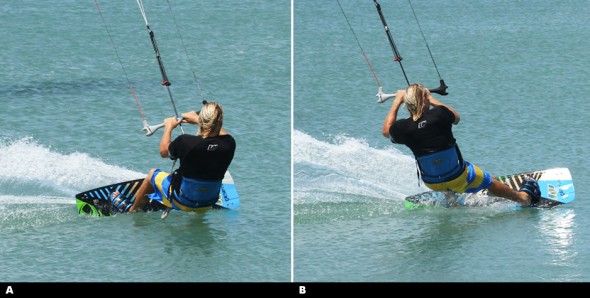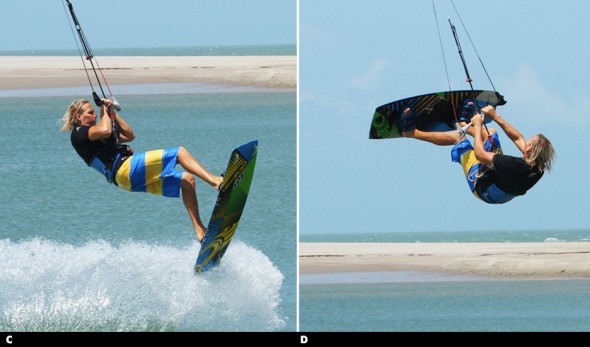Double Back Rool Transition
Adding together some extra rotation is a sure shot fire way of stepping up a move that you already have mastered, and the double back roll transition is definitely up there as one to learn, so here it is. Although some warning words are here, if you’ve been practicing the double back roll kite loop from last issue, you may require to rewire your brain and press default as these are two clearly different moves wherein you definitely don’t wish to be confusing. A very good base before starting this is a solid and controlled, BLT, or back roll transition if you’re from across the pond. From this point below is what you will be doing.
The Approach Pic A.
Vital 2 things to remember for any transition are; you have to kill some forward momentum and then you still need to send the kite for lift. You certainly require a good edge for both of these elements. From a good edge you can edge harder upwind to slow down, and with a good edge you can send the kite rapidly and sharply from either 11 or 1 to 12 o’clock because you maintain tension in the lines. If you think about this you won’t drift the kite up slowly whilst standing up on the board and your chances of success will be greatly increased. Please note and also see in Pic A that the rider has come in with good speed on a decent edge, kite at 11 o’clock, weight back and tension in his lines.
From this point the rider has sent the kite up whilst edging harder to both resist the pull, and also to slow down. Even though his back leg is bent it is not soft – it is pushing and therefore resisting.
The Rotation Pic B.
A certain element of trial and error with good amount of practice is what required for this part, depending on your standard BLT. In case if you are a recognized exponent of slow, casual-looking back roll transitions then speeding up the rotation to accommodate an extra 360° shouldn’t hold much of a problem. If however you’re guilty of the occasional foray into spinney quick low BLTs, then you’ll need to focus more on your approach and the take-off, in search of more height and float, which added to your spin speed should see you nicely round the full double.
We feel it extremely important to mention here that that you do want to help yourself into the second rotation, but you don’t want to force it as later in the move you can use your head, body and kite to help you finish. The rider I Pic B. has dropped his weight way back over the tail of the board. With his weight so far back the board will turn/carve much further into the wind as it is almost pivoting on its tail. This will efficiently speed up the rider’s rotation as he will carve further into wind before take-off than for his standard BLT.
The important tool here is timing, you must drop back as the kite starts to lift, a fraction before you take off. This way you’ll still edge and therefore be rewarded with some air and float. If you drop back too early you’ll be pulled back and the kite will fly further back in the window, offering you less time in the air to make it round the two times.
Take Off Pic C.
Here comes the key moment, though your approach will dictate how this goes. If you have edged and resisted and literally stabbed the kite back hard but face short time you will be able to pop up off your back leg as you pull the bar in whilst the kite is somewhere close to 12 o’clock.
The rider has pulled the bar right in after popping. The reasons for this are twofold. Firstly by pulling in hard with 2 hands the rider successfully stops the kite moving and keeps it centered above bias around 12 o’clock. Secondly he gets a cheeky bit of extra lift from the kite. However be cautioned if your sweet spot is trimmed miles away from you, your kite will flare/stall and you will not get the float or control that you’re expecting. As he takes off he keeps his head looking forward between his arms, which will stop him over cooking the rotation. Finally the rider in this image lifts his knees, making himself small, balanced and easier to rotate.
By the time you reach to the peak of your transition, your aim is to complete your first rotation, so one on the way up and then one on the way down. That means unless you’re getting great height there won’t be much time to separate the move into two halves.
You are ready and primed to go into number two as you complete the first 360°, it’s the most important thing here. Check images number D. that the rider has lifted his feet above him and has his knees pulled in close. This a little inverted position will make it much simpler to finish the move, as with your feet high and knees in, your whole body, legs and board will follow your head and shoulders as you turn into the second rotation. It is absolutely possible to finish the move with the board down low, however you are far more likely to finish with your head and shoulders, but find that the board has been left somewhat behind – which will hinder your smooth landing. In picture you can see that the rider has started to pull, gently at first, on his left hand (old back hand, new front hand – whichever way you prefer to think). This gentle movement of bar and kite will encourage you to lean back into the second rotation
Turn and land pic- E
Your second rotation will come from a combination of your head and the kite. With your feet up look around and you’ll continue to turn and the rest will follow. You can see that the rider is attentive on where he will land, and as soon as he feels that he is rotating, he dives the kite down hard. The pull from the kite twists him around and powers him up for a down wind landing.
One thing which really important is Timing here in this trick , but if you pull too early the kite will end up low with little power and as such you’ll be forced into a late kite loop once you have landed to keep you dry. If you time the dive well, you’ll get the perfect dry landing without needing to loop the kite.
Top Tips
- Start with some single BLTs, focused on the edge, send, upward take off and keeping the kite above you at 12 o’clock throughout the move.
- Once you’re comfortable, confident and consistent bring your feet up and go for the second rotation whilst keeping the kite at 12.
- Once this is in the bag you can dive hard to add the perfect 10 landing! If you’re struggling with the slow rotation, concentrate on the up rather than the spin and approach with less speed and more edge, whilst sending more aggressively – but just for a short moment.
Common Problems
- The most common problem here is implementation the move but landing with the kite so for at the edge of the window that there is no way to get any power to get moving.
- There are two probable reasons for this. Firstly you’re drifting the kite up rather than sending, so you feel the lift late and the kite has already travelled too far behind you.
- Secondly as you take off your leaning back onto your back hand, so you don’t stop or even redirect the kite to 12. Concentrate on performing the move with the kite at 12 o’clock and then add the kite dive on at the end.
- The other famous problem is not having enough height to land cleanly, so you are completing the double but always landing on an edge across the wind with your burn in the water.
- This can generally be linked with concentrating too much on the rotation and not launching yourself up into the move. Make an effort to pop up into the rotation, and not just carve around into the wind.
Some Keystones
- Good solid edge with legs resisting
- Send kite positively with confidence
- Pop up into the back roll and center bar
- Keep Kite at 12 o’clock and lift legs
- Turn head at apex and dive kite to complete number two


Leave a Reply